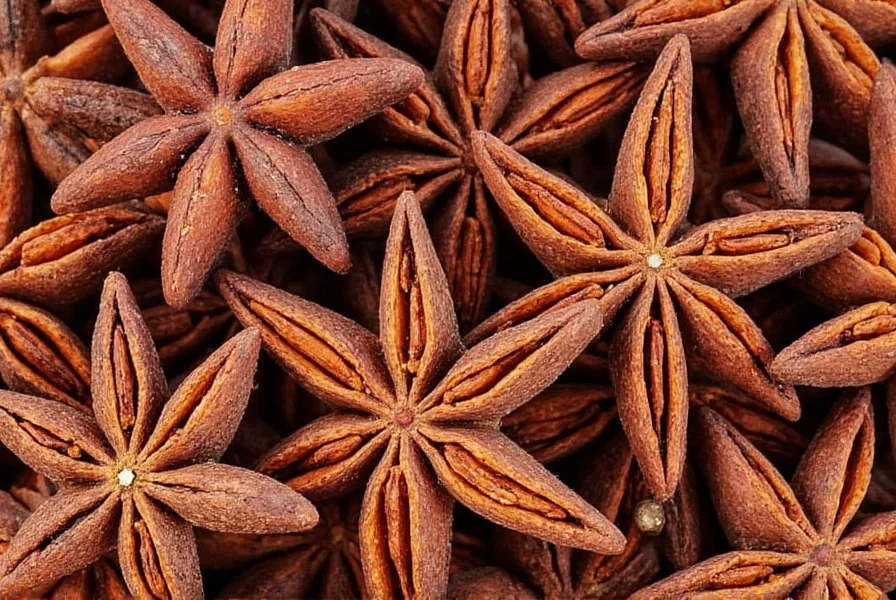Star anise (Illicium verum) stands as one of the most visually distinctive spices in the culinary world. This reddish-brown spice measures approximately one inch in diameter and consists of eight carpels arranged in a perfect star formation, each containing a single seed. The unique appearance makes it instantly recognizable among pantry staples, though its potent flavor demands careful handling in recipes.
Botanical Origins and Production
Grown primarily in China, Vietnam, and India, star anise develops on evergreen trees that reach 20-50 feet in height. The fruit is harvested while still green and then sun-dried until it transforms to its characteristic deep reddish-brown color. This drying process concentrates the essential oils responsible for star anise's powerful aroma and flavor. Unlike many spices, star anise maintains its potency remarkably well when stored properly, often retaining quality for up to three years.
Flavor Profile and Culinary Applications
The dominant flavor compound in star anise is anethole, the same compound found in anise seed and fennel, though star anise contains it in higher concentrations. This gives it a more intense licorice-like flavor with subtle notes of citrus and clove. Chefs prize star anise for its ability to add depth to both sweet and savory dishes without overwhelming other ingredients when used judiciously.
Professional kitchens typically use whole star anise in slow-cooked dishes where the spice can be easily removed before serving. Ground star anise works better in baked goods and spice blends where uniform distribution matters. The spice plays a starring role in:
- Chinese five spice powder (along with cloves, Chinese cinnamon, Sichuan pepper, and fennel seeds)
- Vietnamese pho broth (providing the characteristic aromatic base)
- Indian garam masala blends
- Biryani rice preparations
- European mulled wines and liqueurs like absinthe
- Chinese red-cooked dishes and braises
| Star Anise Characteristic | Detail |
|---|---|
| Botanical Name | Illicium verum |
| Native Region | Southwest China, Northeast Vietnam |
| Primary Flavor Compound | Anethole (90% of essential oil) |
| Shelf Life (whole) | 2-3 years when properly stored |
| Common Culinary Pairings | Cinnamon, cloves, ginger, orange, pork, duck |
Star Anise vs. Anise Seed: Clearing the Confusion
Despite their similar names and flavor profiles, star anise and anise seed come from completely different plant families. Star anise (Illicium verum) belongs to the Schisandraceae family, while anise seed (Pimpinella anisum) is part of the Apiaceae family (which includes carrots and parsley). This botanical distinction explains why star anise has a more intense, complex flavor profile compared to the milder, sweeter anise seed.
When substituting between these spices, use approximately one star anise pod for every 1/4 teaspoon of anise seed called for in a recipe. However, for dishes where star anise is a featured ingredient (like pho or Chinese braises), substitutions will significantly alter the authentic flavor profile.
Selecting and Storing Star Anise
When purchasing star anise, look for deep reddish-brown pods with intact points and a strong, sweet aroma. Avoid pieces with dull color or musty smells, which indicate age or improper storage. Whole star anise maintains its flavor significantly longer than ground versions.
Store star anise in an airtight container away from light and heat. Properly stored, whole star anise retains optimal flavor for 2-3 years, while ground star anise begins losing potency after 6-12 months. For maximum flavor impact, lightly toast whole pods before use to release their essential oils.
Culinary Substitutions and Techniques
When star anise isn't available, consider these alternatives based on your recipe:
- For savory dishes: Use 1/2 teaspoon anise seed plus 1/4 teaspoon fennel seed per star anise called for
- For baking: Substitute 1/4 teaspoon anise extract per star anise (reduce other liquids accordingly)
- For tea preparations: Combine equal parts fennel seed and licorice root
When using whole star anise in cooking, add it early in the process to allow flavors to infuse. Remember to remove the whole pods before serving, as they remain quite hard even after prolonged cooking. For ground applications, add toward the end of cooking to preserve volatile flavor compounds.

Traditional Uses Beyond Cooking
Beyond its culinary applications, star anise has featured prominently in traditional Chinese medicine for centuries. It commonly appears in herbal preparations aimed at supporting digestion and respiratory health. The spice also serves as the primary source of shikimic acid, a key compound used in producing the antiviral medication oseltamivir (Tamiflu).
Food historians note that star anise traveled along ancient spice routes from China to Europe during the 17th century, though it never gained the same popularity in Western cuisines as other spices like cinnamon or cloves. Today, it remains indispensable in Asian cooking while gaining recognition among adventurous Western chefs exploring global flavor profiles.

Practical Cooking Tips for Home Chefs
When incorporating star anise into your cooking, consider these professional techniques:
- Infused liquids: Add one whole pod to simple syrups for cocktails or desserts
- Rice dishes: Toss one pod into the cooking water for jasmine rice
- Meat preparations: Place pods inside poultry cavities before roasting
- Tea blends: Steep one pod with black tea and orange peel for a warming beverage
- Spice grinding: Remove seeds from pods before grinding for smoother texture
Remember that star anise's flavor intensifies with cooking time, so adjust quantities based on whether your dish requires short or long cooking periods. For quick-cooking applications, consider using ground star anise for more immediate flavor release.











 浙公网安备
33010002000092号
浙公网安备
33010002000092号 浙B2-20120091-4
浙B2-20120091-4